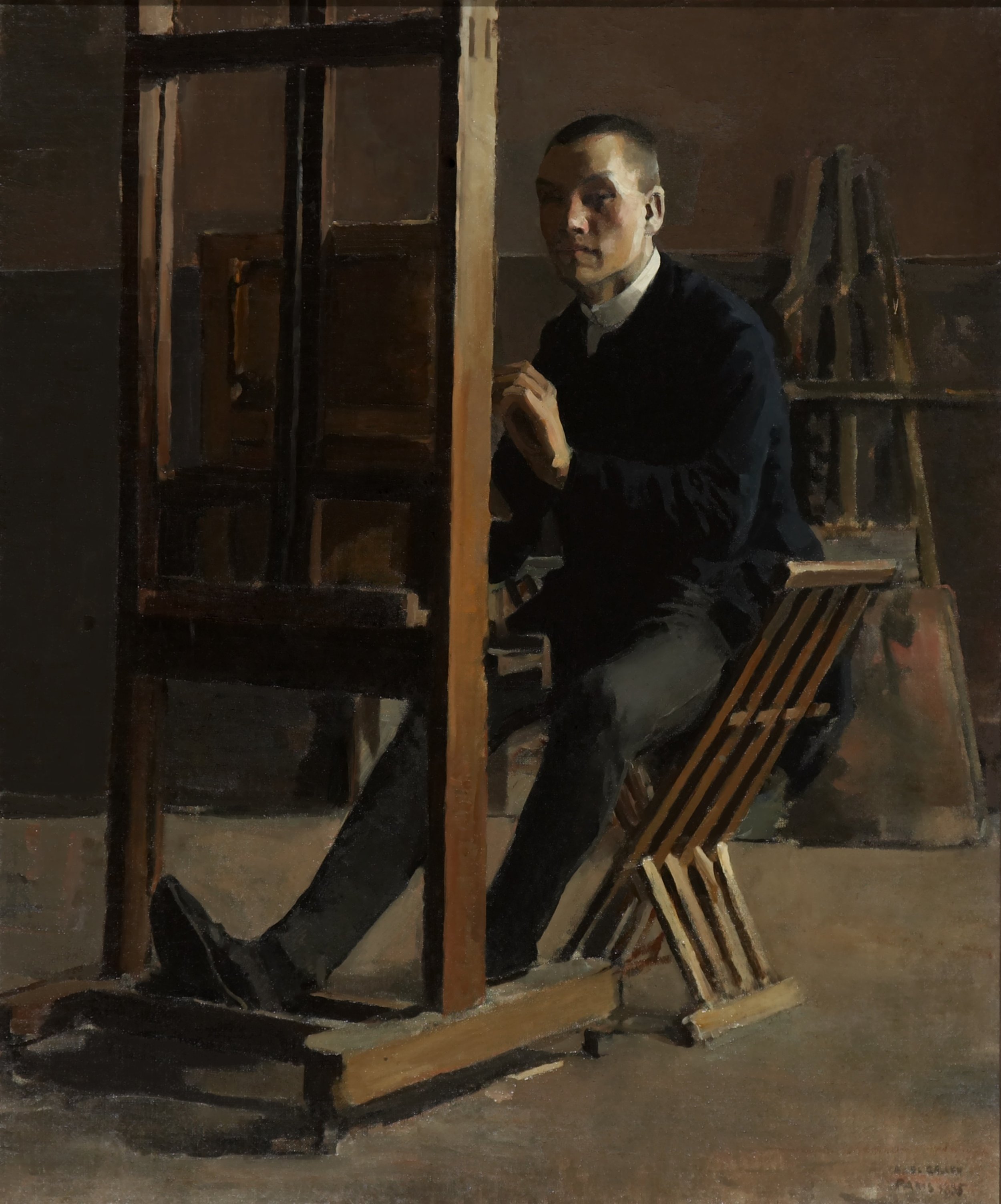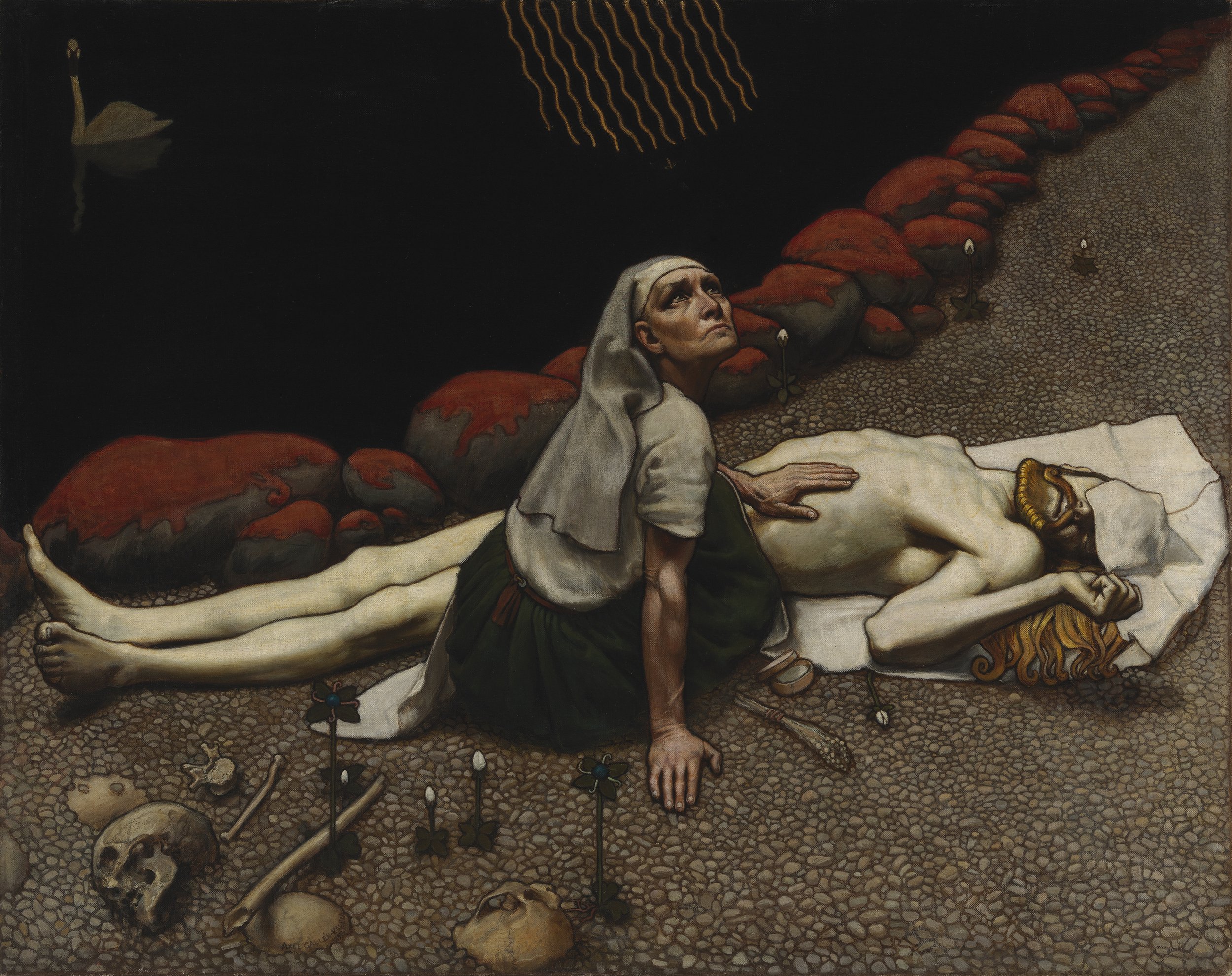Akseli Gallen-Kallela catalogue raisonné project
Akseli Gallen-Kallela: Self-portrait at the Easel, 1885. Private collection. Photo: Janne Gallen-Kallela-Sirén
Nordic Art Intelligence’s first catalogue raisonné project focuses on Akseli Gallen-Kallela (1865–1931) with the aim to document all paintings by the Finnish artist. It can be visited at https://gallenkallela.org/.
This project was launched with private funding in October 2018 and is based on more than 40 years of research into the artist’s oeuvre by his granddaughter, Aivi Gallen-Kallela-Sirén. The first step was to digitize all existing research that is now being augmented with information held in the databases and archives of museums, libraries, and foundations, including those of the Ateneum Art Museum – Finnish National Gallery, Gösta Serlachius Fine Arts Foundation, National Library of Finland and Turku Art Museum.
In September 2021, Nordic Art Intelligence assumed responsibility for the project. Each artwork will be accompanied by an image and descriptive information, such as title, date, medium, dimensions, signatures, and other inscriptions. The catalogue will list the known provenance, as well as exhibition and publication histories, for each work.
The Akseli Gallen-Kallela catalogue raisonné project will be published online and will be freely accessible to the public.
The digital catalogue is opened to the public in February 2024.
Akseli Gallen-Kallela: Lemminkäinen’s Mother, 1897. Finnish National Gallery / Ateneum Art Museum, coll. Antell. Photo: Hannu Pakarinen / Finnish National Gallery
Akseli Gallen-Kallela
Akseli Gallen-Kallela (1865–1931) is one of the most important figures in Finnish art history. During his fifty-year career, he produced a rich and diverse oeuvre that ranges from painting and graphic arts to applied arts, such as textiles and furniture. Gallen-Kallela was a chronicler of Finnish life — the country’s people, myths, and landscape. He is especially remembered for his illustrations and paintings of the Finnish national epic, the Kalevala. At the same time, Gallen-Kallela was a cosmopolitan artist, who was profoundly interested in the latest ideas and influences within art and contributed towards their development. Axel Gallén officially adopted the Finnish form of his name, “Akseli Gallen-Kallela,” in 1907.
Gallen-Kallela studied at the Académie Julian and Atelier Cormon in Paris between 1884 and 1889, where he became part of a group of Nordic artists that included the Finnish artists Albert Edelfelt, Eero Järnefelt, and Emil Wikström, Norwegian artists Edvard Munch and Carl Dørnberger, and the Swedish writer August Strindberg. In Paris, Gallen-Kallela painted urban vistas and depictions of the bohemian lifestyle of the fin de siècle. During his studies, the artist also spent long periods of time in his homeland and painted the rural landscape of Finland in a naturalistic style.
Gallen-Kallela’s lifelong passion was the Kalevala — a collection of poems of Finnish folklore passed down through generations. In the summer of 1890, the artist, his fiancée Mary Gallén (née Slöör), and his Swedish colleague, Louis Sparre, journeyed to the songlands of the Kalevala: Kuhmo and Russian Karelia. This formative trip, which was both a honeymoon and an artistic mission, inspired and strengthened a Karelia-oriented cultural movement in Finland.
In the 1890s, Gallen-Kallela turned to Symbolism. During this decade, Gallen-Kallela painted many of his famous Kalevala works, such as The Defense of the Sampo (1896), Lemminkäinen’s Mother (1897), and Kullervo Cursing (1899). In Finland, the Symbolist movement was intertwined with Karelianism and the National Romantic style. Besides the Kalevala, Gallen-Kallela also created illustrations for Aleksis Kivi’s novel, The Seven Brothers (1870) — widely considered the first significant novel written in Finnish.
The highlight of Gallen-Kallela's international career was the Finnish pavilion at the Paris 1900 World Fair, filled with frescoes based upon the Kalevala. Together with Louis Sparre, Gallen-Kallela created the interior design for the pavilion’s Iris Room.
The pavilion was great success and brought Finland, then in the middle of Russification, to the center of international attention. Beyond the Paris World Fair, Gallen-Kallela left his mark upon Finnish architecture and design with the two studios that he conceived and built: Tarvaspää in Espoo and Kalela in the wilderness of Ruovesi. Constructed in 1895, this rural studio is one of the most famous examples of National Romantic architecture in Finland.
Gallen-Kallela was a tremendously versatile artist, who mastered several artistic methods and materials through his career. During the 1890s, the artist travelled to Berlin, London, and Florence, where he learned glass and fresco painting, and different printing techniques. From his studio in Ruovesi, Gallen-Kallela would further develop these methods and create the first modern Finnish graphic art.
Between 1909 and 1910, Gallen-Kallela traveled with this family to British East Africa, now roughly the same territory as present-day Kenya. During two years in Africa, the artist painted almost two hundred Expressionist paintings. When he returned to Finland, Gallen-Kallela established his second studio in Espoo. The castle-like Tarvaspää was built in 1911–13. Gallen-Kallela’s next great journey took place between the years of 1923 and 1926, when he traveled to the United States. The artist and his family stayed in Chicago and then Taos, New Mexico, where he studied the art of the Native Americans. From the United States, Gallen-Kallela was once again drawn to the mythic tales of the Kalevala.
Gallen-Kallela’s career runs in parallel to some of the most pivotal moments of Finnish history. His lifetime marked the period of nation-building, which culminated in 1917 with the Finnish declaration of independence. Following the Finnish Civil War in 1918, Gallen-Kallela served as an adjutant for the regent Carl Gustaf Emil Mannerheim and designed uniforms and medals for the independent Finnish army.
Akseli Gallen-Kallela impact upon Finnish culture cannot be overstated. To this day, Gallen-Kallela’s depictions of Finland’s landscape, people, and myths form a shared visual language for every Finn. The influence of the artist also extends beyond his country’s borders. Gallen-Kallela was recognized during his lifetime as a profoundly important figure, whose work was exhibited across Europe and North America. Knowledge of Gallen-Kallela’s life and oeuvre continues to grow as new audiences discover his work through exhibitions and scholarship.
Some of Akseli Gallen-Kallela’s most famous works of art include: Boy with a Crow (1884), Old Woman with a Cat (1885), Démasquée (1888), In the Sauna (1889), The Aino Myth, Triptych (1891), The Forging of the Sampo (1893), Symposion (1894), Flower of Death (1895), The Fratricide (1897), Joukahainen's Revenge (1897), Kullervo Sets off for Battle (1901), By the River of Tuonela (1903), Lake Keitele (1904), The Theft of the Sampo (1905), The Lamenting Boat (1907), illustrations for the “Koru-Kalevala” (1922), Ilmarinen Ploughing the Viper Field (1928), The Great Pike (1928), The Forging of the Sampo (1928), and The Defense of the Sampo (1928).

